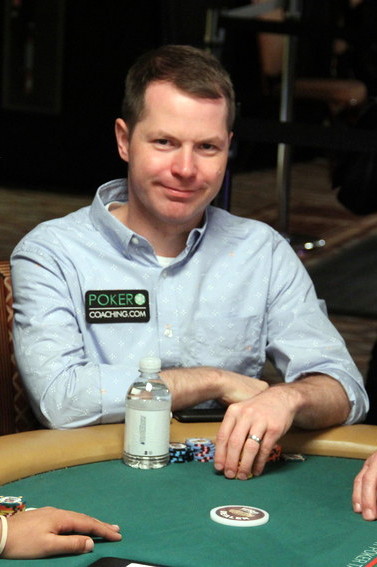






Turning Quads And Getting Paidby Jonathan Little | Published: Sep 06, 2023 |
|
|
 If you want to increase your poker skills and learn to crush the games, check out Jonathan Little’s elite training site at PokerCoaching.com/CardPlayer.
If you want to increase your poker skills and learn to crush the games, check out Jonathan Little’s elite training site at PokerCoaching.com/CardPlayer.
In the middle of the third day of a five-day $3,500 buy-in tournament, the blinds were 4,000-8,000 with an 8,000 big blind ante. I had 450,000 and all my opponents had me covered.
I raised to 19,000 with J J
J from middle position and the hijack, a loose, splashy player, called. Everyone else folded.*
from middle position and the hijack, a loose, splashy player, called. Everyone else folded.*
The flop came J 7
7 6
6 .
.
The best hand to slowplay is top set because when you have two of the top card on the board, it is highly unlikely your opponent has a strong hand that can put a lot of money in the pot.
However, due to the coordinated nature of this board, it is somewhat likely that my opponent has a marginal made hand or a draw. If I bet, my loose, splashy opponent may even decide to bluff, making this an excellent spot to bet.
I bet 26,000 into the 59,000 pot and my opponent called.
The turn was the J . That is lucky!
. That is lucky!
While slow playing quads certainly has merit, I thought the best way to get a large portion of my stack in the pot was to continue betting. If my opponent has a marginal hand like 8-8 or middle pair, he will probably check behind if I check, which would be a disaster because those hands will certainly call a turn bet.
Even if my opponent decided to bet a marginal made hand, he will almost certainly not bet again on the river. And if I check-raise the turn, he will likely fold. Unless I think my opponent’s range is full of unpaired hands, betting is the only play that makes sense.
 I bet 40,000 into the 111,000 pot and my opponent called. The river was the 8
I bet 40,000 into the 111,000 pot and my opponent called. The river was the 8 .
.
Since I thought my opponent’s range going to the river was almost entirely marginal made hands and draws (which would now be middle pair or a straight), it doesn’t make sense to bet huge. Most opponents will only call a small bet with their worst made hands. If for some reason I thought my opponent was a calling station, a larger bet would have been ideal.
I bet 57,000 into the 191,000 pot. To my surprise, my opponent instantly raised 157,000, making it 100,000 more.
At this point, I assumed my opponent’s range was very polarized to premium value hands and bluffs. If he is bluffing, he will fold no matter what I do, so I do not need to be concerned about that portion of his range.
Most players are not capable of getting away from a premium hand on the river to any re-raise size, meaning I should now go for maximum value.
After matching my opponent’s raise, I had 207,000 left in my stack, which I pushed all-in. My opponent instantly called with A 6
6 , a flopped bottom pair that backdoored into a flush, awarding me a gigantic pot.
, a flopped bottom pair that backdoored into a flush, awarding me a gigantic pot.
I want to make it perfectly clear that I think my opponent should have folded to my river all-in. Unless he thinks I am blatantly crazy, my river bet/re-raising range is almost entirely full houses and a few bluffs.
After the hand, my opponent was beating himself up for raising my initial river bet of 57,000. I think his river raise is certainly fine because I should have trips a large amount of the time and will at least consider calling a raise. If he thinks I will call a river raise with trips, raising the river with the flush is a great play, but if he thinks I will fold trips to a river raise, he should just call.
If he decides to raise, as he did, he must be disciplined enough to get away from his hand once it becomes clear that I think I have the nuts. Even when you have an extremely strong hand, when your opponent is playing as if he has the actual nuts, you must be disciplined enough to get out of the way because almost no one bluffs often enough on the river.
If you want more resources to help you improve your game, I put together a course called The 25 Biggest Leaks and How to Fix Them. This course is completely free inside the Card Player Poker School!
When you join the Card Player Poker School (it’s free to join), you’ll also get:
✔ Free downloadable preflop charts
✔ GTO preflop charts
✔ Video Classes
✔ Interactive Hand Quizzes
✔ Free Course: Master the Fundamentals
✔ Free Course: The 25 Biggest Leaks and How to Fix Them
✔ Free training every week
 Jonathan Little is a two-time WPT champion with more than $7 million in live tournament earnings, best-selling author of 15 educational poker books, and 2019 GPI Poker Personality of the Year. If you want to increase your poker skills and learn to crush the games, check out his training site at PokerCoaching.com/cardplayer.
Jonathan Little is a two-time WPT champion with more than $7 million in live tournament earnings, best-selling author of 15 educational poker books, and 2019 GPI Poker Personality of the Year. If you want to increase your poker skills and learn to crush the games, check out his training site at PokerCoaching.com/cardplayer.
Features
Tournaments
Strategy
Commentary & Analysis